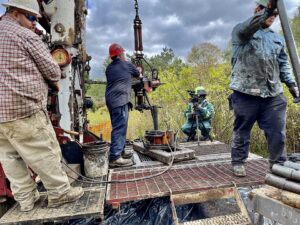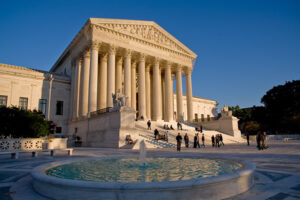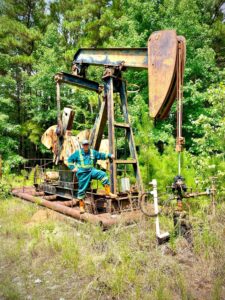It sounds like it could be a new dance (“Let’s do the frack!”). Or maybe it’s a cool way to clean your house (“I really fracked my floor this week; it looks great now!”)
But it’s not. Fracking is short for “hydraulic fracturing,” explains Chris Bolgiano in this Bay Journal article. “It involves drilling a hole a mile down, then thousands of feet horizontally, and pumping down millions of gallons of water laced with sand, salt and chemicals to crack the shale. Gas is forced up, along with roughly 25 percent of the contaminated wastewater, often hot with radioactivity.”
Chris adds, “Fracking chemicals include formaldehyde, benzene, and others known to be carcinogenic at a few parts per million. Municipal plants can’t handle fracking wastewater, and it’s stored in open pits until trucked elsewhere. If enough fresh water can’t be sucked from streams on site, trucks haul it in.
“Eighteen-wheelers rolling 24/7 pulverize country roads and cause accidents, like the one that spilled 8,000 gallons of toxic materials into a Pennsylvania creek last year. And they emit enough carbon to seriously shrink the greenhouse gas advantage of fracked gas.”
Fracking is rampant up and down the Eastern Seabord right now, as the natural gas industry tries to tap the gas that’s trapped under a massive underground rock formation called the Marcellus Shale. But it’s also occurring in the Midwest and southwest, 36 states in all. The industry claims that it’s doing the public and the environment a service, since the U.S. has abundant natural gas reserves and natural gas emits half the carbon emissions of coal and oil. Plus, says the industry, fracking creates local (though temporary) jobs.
But here’s the very significant downside:
EXPLOSIONS
Fracking causes explosions similar to the oil blowup that occurred in the Gulf of Mexico last year. One explosion in Pennsylvania last June spewed flammable gas and polluted water 75 feet into the air for sixteen hours. A blast in West Virginia injured 7 people while flames shot 40 feet into the air.
TAP WATER ON FIRE
Over 1,000 cases of water contamination have been reported near fracking sites, reports Food and Water Watch. Fracking operations in Pennsylvania alone are expected to create 19 milion gallons of wastewater. The Oscar-nominated documentary GasLand captured this tap water catching on fire because it contained so much methane as a result of drinking water contamination from nearby fracking operations.
WORSE FOR CLIMATE CHANGE
About that methane: According to the Environmental Protection Agency, methane is 21 times more damaging a greenhouse gas than carbon dioxide. Similarly, a study released by researchers at Duke University in April found methane levels in shallow drinking water wells near active gas drilling sites at a level 17 times higher than those near inactive ones.
AND — WHO’S SURPRISED? — CANCER
Scientists at the Endocrine Disruption Exchange who tested fracking fluids found that 25 percent can cause cancer; 37 percent can disrupt our endocrine system; and 40 to 50 percent can affect our nervous, immune and cardiovascular systems.
HERE’S WHAT YOU CAN DO
Citizen, public health and environmental groups cheered yesterday when New Jersey’s state legislature became the first in the nation to unanimously ban fracking. Said Senator Bob Gordon (D-Bergen), “Any benefits of gas production simply do not justify the many potential dangers associated with fracking such as pollution of our lakes, streams and drinking water supplies and the release of airborne pollutants. We should not wait until our natural resources are threatened or destroyed to act. The time to ban fracking in New Jersey is now.”
New Jersey is a good start, but remember: Fracking is currently underway in 36 states. Here’s what you can do to stop it in your state.
On Capitol Hill, the FRAC Act, a bill that has been in the Senate since 2009, would force the natural gas industry frackers to comply fully with the Safe Drinking Water Act and protect our drinking water. You can easily sign a petition here to ask your Senators to support the FRAC act.
Do it today.
Want to Read More?
Fracking in Maryland: Chesapeake Bay Foundation Petitions White House

















6 thoughts on “What the Heck is Fracking? And Why Don’t You Want It Anywhere Near Your Water?”
It’s rare as a “Jersey Girl” these days that I get to be proud of my state for something in the news. Between this and sponsoring the cosmetics act that’s two recently! Glad fracking’s not going to happen here. I was reading just yesterday a kindle e-book titled “chemicals used in hydraulic fracturing”, which was rather eye opening to me in explaining the sheer volume of toxic chemicals used in the process. The article you linked to in the NY times was also very enlightening.
Yay, Jersey! Now let’s hope lots of other states follow suit.
The land I was trying to buy in South Haven, MI which was “fracked” back in the 50s; they were using salt water to drill with at the time. It poisoned the ground water so bad that the ground water that’s left must be pumped up and into holding ponds to air off before it can be used to water nearby blueberry fields — 60 years later they are still dealing with the results of a poor decision.
OK,
I own a prius, I use recyclable shopping bags, etc…I’m down with the green, but a question…. Other than just “not doing it”… what is the proposed alternative? Or, if you “dont do it” what does that mean for getting the gas?
Well, for the long term, we need to put more state and federal resources into developing technologies that use solar, wind, and geothermal, rather than gas, oil, and coal. But for the short term, this industry could do a much, much better job on the safety side – containing the water it pollutes, finding a better way to get at the natural gas than fracturing the rock, etc. We need to put a priority on people’s health, not on fossil fuels.
What a great explanation of the significant downside of this technology. Esp. interesting that it may not even fulfill the promise of lowering the carbon footprint of our energy use.
Comments are closed.